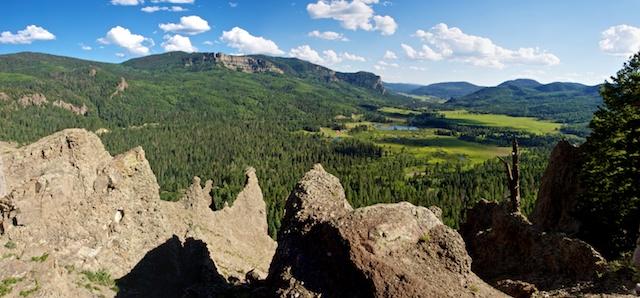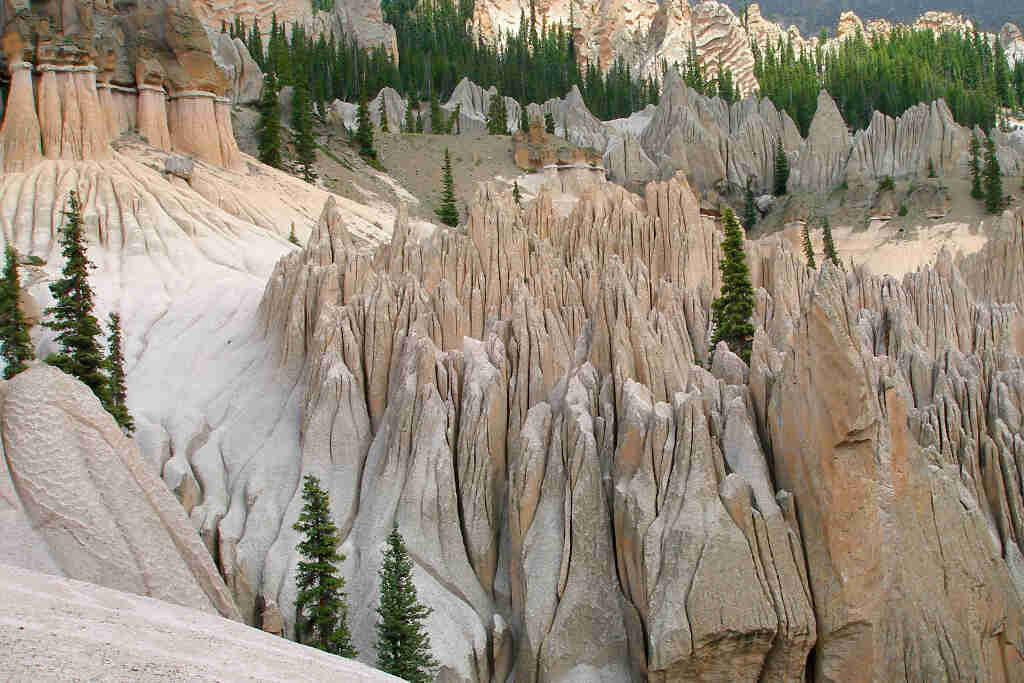Wheeler Geologic Area
Full Article
The Wheeler Geologic Area is a sixty-acre volcanic rock formation located within the La Garita Wilderness in the San Juan Mountains of southern Colorado. A prehistoric time capsule, Wheeler has in more recent years inspired two presidential interventions and tested both state and federal public land-management policies. Declared Colorado’s first national monument by President Theodore Roosevelt in 1908, Wheeler later reverted to the Rio Grande National Forest in 1950. Official neglect and loose regulations left the area vulnerable to vandalism until 1993, when it was included in an expansion of the La Garita Wilderness.
The haphazard history of Wheeler’s management demonstrates the tension between expanding human development in the American West and maintaining the region’s ecosystems and natural habitats. In part the tension arises from the intersection between changing conceptions of nature and Coloradans’ passionate feelings about land use and development.
Volcanism
The forces that shaped the Wheeler Geologic Area started 29 million years ago, during the Oligocene Epoch, when the Rio Grande Rift transformed the landscape of what’s now southern Colorado. The rift, which runs north-south from central Colorado to the Mexican state of Chihuahua, pulled apart the Earth’s crust, causing volcanic activity as the stretched and weakened tectonic plate allowed magma to rise to the surface. At the northern end of the Rio Grande rift lie the fifteen calderas of the San Juan volcanic field. These gargantuan but dormant stratovolcanoes are located in the present-day counties of Saguache, Mineral, Hinsdale, and Rio Grande.
The Wheeler Geologic Area sits deep within the La Garita Caldera (formed 28 million years ago), the geological remnant of one of the world’s largest known volcanic eruptions. It was first mapped and named for the nearby mountains in the 1950s and 1960s. This “supervolcano,” which geologists call a caldera complex, left a twenty-one-by-forty-six-mile depression in the earth. Subsequent eruptions deposited lava, tuff (ash), and breccia (rubble), creating layers of loosely cemented debris. Erosion from freezing temperatures, precipitation, and wind shaped the layers into an array of spiral, pinnacle, and dome rock formations.
Wheeler consists of three distinct layers that reveal a timeline of volcanic eruptions. One million years after La Garita, the Cochetopa and San Luis Volcanos erupted, creating new deposits. The San Luis Caldera Complex released three ash-flow eruptions that produced the Cebolla Creek Tuff, the Nelson Mountain Tuff, and the Rat Creek Tuff. These granite tuff layers are composed primarily of two types of silica-rich igneous rock: rhyolite and dacite.
This recurrent volcanic activity also mineralized the land, leaving behind deposits of precious metals and minerals that would later serve as the foundation for nearby mining towns such as Creede.
History
There is little information regarding prehistoric human activity at Wheeler. Wheeler lies within the ancestral home of the Ute people, who inhabited western Colorado, Utah, and northern New Mexico until they were forced to resettle in the nineteenth century. When traveling at higher elevations, family units would commonly shelter under rock formations. If they were active at Wheeler, however, they left no surviving petroglyphs or other archaeological evidence.
One of the earliest Euro-American encounters with Wheeler came in 1848, during soldier-explorer John C. Frémont’s disastrous expedition that ended in rumors of cannibalism.
National Monument
Interest in Wheeler rose in the early 1900s thanks to Frank C. Spencer, supervisor of the San Juan National Forest and history professor at Adams State Teachers College (now Adams State University). In 1907 Spencer heard about a set of caves from a Ute sheepherder grazing nearby and organized a scouting party to explore the area. Spencer loved it. He lauded the area as a “wonderland” containing an “endless variety of curiously carved forms . . . in nature’s most gorgeous hues.” His party christened different areas of Wheeler, such as the Cathedral, the Cyclops, and Dante’s Lost Souls, names that are still used today.
The following winter, Spencer nominated Wheeler for monument status to the inaugural head of the US Forest Service, Gifford Pinchot. Pinchot was close friends with President Theodore Roosevelt, and their friendship influenced Roosevelt’s decision to designate the 300 acres comprising the Wheeler Geologic Area as Colorado’s first national monument on December 7, 1908. Roosevelt made Wheeler one of the first eighteen monuments he established under the American Antiquities Act on account of its “unusual scientific interest.”
The first proposed name for the area, Frémont National Monument, was rejected because too many Frémont place names already existed. Instead, Colorado’s first national monument was named for late nineteenth-century army surveyor George Montague Wheeler. Between 1872 and 1879, Wheeler and his team assessed areas of California, Nevada, Arizona, New Mexico, and Colorado, producing numerous maps, natural-resource data, and surveys of Indigenous peoples. Wheeler mapped roughly one-third of Colorado but never visited his namesake monument.
Tourist Boom and Bust
After its designation as a monument, Wheeler received waves of enthusiastic visitors. Its popularity coincided with the World War I–era “See America First” campaign, a joint venture between railroad companies and the National Park Service to promote domestic tourism. Families from the Front Range traveled to Wheeler on the Denver & Rio Grande line, lodged in Creede and Wagon Wheel Gap, and rode horseback through the forest to reach the remote monument. Forest rangers built a stock trail, cabin, and corral to accommodate visitors. Throughout the 1910s, hyperbolic advertising described Wheeler as “more magnificent than any other region in the world” and “a rival of Yellowstone National Park.”
Fanfare for Wheeler soon dissipated, however, because without easy access from a paved highway, it failed to meet the needs of a burgeoning middle class that preferred to travel by car. Mineral County planned to attract thousands of seasonal tourists by building a scenic mountain highway from Creede to Wheeler. Officials hoped the tourist revenue would offset the declining mining industry, while local businessmen dreamed that Wheeler would become the next great national park.
Instead, the National Park Service blocked road construction to prevent overdevelopment. Additionally, the park service never secured proper funding or management for Wheeler, keeping it under the superintendent of Mesa Verde National Park, some 100 miles away. With no paved road or effective management, the monument fell into disarray and attendance steadily declined. On August 3, 1950, Congress abolished Wheeler’s monument status because of “very limited visitation,” reverting the land back to the Rio Grande National Forest.
Conservation Efforts
Wheeler technically remained a protected area within the forest but without any clear regulations or special enforcement. In 1962 the Forest Service increased Wheeler’s boundaries to 640 acres. Seven years later, the former monument was renamed the Wheeler Geologic Area. Starting in the 1950s, US Geological Survey scientists such as Thomas A. Steven had begun to recognize that the area was the erosional remnant of an ancient volcanic field. In the mid-1960s, Steven worked with Peter W. Lipman and others to map nearly all the old calderas in the San Juan Mountains. Their study, considered a gold standard in its field, revealed a dozen of the largest eruptions in North America. By 1969 they had mapped the entire La Garita Caldera where the Wheeler Geologic Area sits. Since then, US Geological Survey teams have continued to remap the area more accurately as technology has improved.
Yet Wheeler’s status as a special “geologic area” within the forest was mostly nominal. It did nothing to prevent vandalism from a fresh generation of tourists driving new off-road vehicles like jeeps and arriving via a new logging road off State Highway 149. Excursions of four-wheelers, jeeps, and dirt bikes damaged the fragile landscape as riders abandoned the road, preferring to travel across open mountain meadows and through the trees. Rainstorms worsened erosion from tire tracks, transforming the meadows into bogs. Additionally, excursionists ripped down trees with their winches, carved graffiti, and drove on top of the rock formations. One notorious Fourth of July excursion in 1969 consisted of seventy-five jeeps from Denver.
Distressed by the destruction, local businessmen and ranchers organized the Rio Grande National Forest Advisory Council to advocate for the interests of the eastern San Juans. They desired responsible off-roading, deplored the destruction of their lands by Front Range residents, and urged the Forest Service to control usage with a road and campground. Taking a more drastic stance, philanthropic businessman Allan Phipps testified at a 1978 Forest Service hearing that the La Garita Wilderness should be expanded to include Wheeler. As a son of Colorado senator Lawrence C. Phipps, Allan had spent childhood summers at the family’s nearby ranch. Environmental organizations such as the Rocky Mountain Center on Environment, the Colorado Open Space Council, and the Sierra Club sided with Phipps and encouraged the expansion, which would ban motorized vehicles from Wheeler.
The Agriculture and Interior Departments, which govern national forests and national monuments, conducted administrative reviews of the Wheeler area, but attempts to include it in a wilderness area or new national monument came up short throughout the 1980s.
Colorado Wilderness Act of 1993
Wheeler allies eventually achieved their goal with the passage of the Colorado Wilderness Act of 1993, introduced by Representative David Skaggs (D–CO) and cosponsored by Representatives Patricia Schroeder (D–CO) and Scott McInnis (R–CO). President Bill Clinton signed their bill into law on August 13, 1993. It set aside 612,000 acres of public land as part of the National Wilderness Preservation System, creating nine new wilderness areas and expanding ten existing ones—including the La Garita Wilderness, which now took in the Wheeler Geologic Area. The Wheeler Geologic Area now covers 25,640 of the wilderness’s nearly 130,000 acres.
Wilderness opponents were upset by the decision, believing the federal government was “locking up” the land. As a compromise with off-highway vehicle (OHV) recreationalists, the bill omitted a four-wheel-drive dirt road from wilderness restrictions. Labeled by the Forest Service as “grueling,” this fourteen-mile exception is a far cry from the paved highway that local boosters once imagined. Today Wheeler remains one of Colorado’s least-visited hiking areas.
Today
The history of the Wheeler Geologic Area demonstrates the challenge of balancing outdoor recreation and local economies with the preservation of public lands. Now Wheeler faces a new problem: the spruce beetle. Discovered in 1996, the irreversible infestation has already killed spruce-fir forests on one-third of the Rio Grande National Forest’s 1.86 million acres. Beetles cannot harm Wheeler’s geology, but no forest-management techniques can effectively stop the infestation. The area’s changing scenery is just one more event for this old monument to weather.





